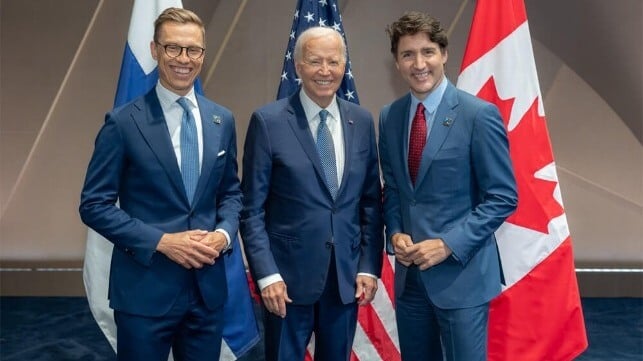US, Canada and Finland Partner to Develop Polar Icebreaker Shipbuilding

With the race on to access the Arctic and expand reach into the Antarctic, the U.S., Canada, and Finland today announced a new collaboration designed to enhance the production of polar icebreakers and hopefully draw more support for other allies. The new initiative was announced on the sidelines of the three-day NATO summit in Washington, D.C., and comes as the U.S. and Canada independently are struggling with their efforts to build a new generation of polar icebreakers.
Known as the ICE Pact (Icebreaker Collaboration Effort) the first objects are to enhance information sharing and to collaborate on workforce development. The governments of the three countries said they intend to leverage shipyards in their countries and expand on the current efforts to build a new generation of polar icebreakers. They will also look to work with like-minded allies and hope to attract additional orders for icebreakers to help offset the massive investments being made in the U.S. and Canada.
The joint statement highlights, “In the Arctic, new, faster shipping lanes hold the potential to create new economic opportunities and drive down shipping costs. In the Antarctic, our partnership can also foster increased scientific research and international cooperation.” The statement concludes by saying, “It is about providing the capability for like-minded nations to uphold international rules, norms, and standards to sustain peace and stability in the Arctic and Antarctic regions for generations to come.”
The U.S. launched its Polar Security Cutter Program which is working with Bollinger Shipyards to build the first new vessel in 50 years for the U.S. Coast Guard’s efforts in the Arctic and Antarctic. The Government Accountability Office has been highly critical of the efforts which is severely overbudget and behind schedule. The USCG is scrambling to keep its last two polar icebreakers in operation till the new vessels can be commissioned. At the same time, the USCG told Congress that it believes it needs eight or nine polar capable icebreakers to counter the initiatives of others such as China which is rapidly building its research fleet.
Canada also has its icebreaker program underway working with Seaspan in Vancouver as well as Irving and Davie. The project has faced similar challenges to the U.S. with reports saying the design of the vessel is only 70 percent complete.
"Without this arrangement, we'd risk our adversaries developing an advantage in a specialized technology with vast geostrategic importance, which could also allow them to become the preferred supplier for countries that also have an interest in purchasing polar icebreakers,” U.S. Deputy National Security Advisor Daleep Singh told reporters during a background briefing.
Experts highlight that the Western allies are far behind in developing icebreakers and other specialized vessels. Singh pointed out that the U.S. only has two polar vessels in operation (Polar Star commissioned in 1976 and Healy commissioned in 1999) while Canada currently has nine icebreakers and Finland has 12. Estimates by comparison are that Russia has been 35 and 40 in service and continues to build more as it works to expand year-round transits of the Northern Sea Route through the Arctic. Canadian shipbuilder Davie says there are more than 80 open projects among Western countries.
Davie acquired the Helsinki Shipyard which they highlight has built more than 50 percent of the global icebreakers. They said the icebreaker and polar expertise of Helsinki Shipyard was a key attraction and an expertise with could be expanded. Associated Press is citing unnamed sources saying that Davie was a driver behind this collaboration as it is ideally positioned to benefit.

that matters most
Get the latest maritime news delivered to your inbox daily.
Seaspan Shipyards also issued a statement welcome the new collaboration while highlighting that it is tasked with designing, building, and delivering 21 icebreaker vessels for the Canadian Coast Guard. The company reports it has delivered three new vessels and a fourth will be delivered early next year. Design is well underway they noted for the heavy Polar icebreaker while they projected that construction will start later this year. Seaspan said it is also well into the design of 16 additional medium icebreaker vessels that will be built and delivered over the next 10 to 20 years.
Announcing ICE PACT, the three countries said they will work to complete a joint memorandum that will outline a framework for the arrangement. They expect to sign the formal agreement by the end of 2024.
